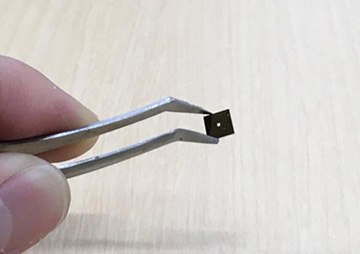
The material linking the three electro-mechano-optical systems, grasped with handheld tweezers. [Image: Kazuyuki Takeda / Kyoto University]
In nuclear magnetic resonance (NMR), atomic nuclei absorb and re-emit electromagnetic radiation at radio frequencies. Researchers at two Japanese universities have upconverted NMR signals to optical frequencies for potentially more sensitive spectroscopic analysis (Optica, doi:10.1364/OPTICA.5.000152).
The new technique uses a thin, elastic silicon nitride membrane, which connects to electromechanical and optoelectronic components to form a radio-to-optical signal transducer. The principles behind this type of signal transduction were discovered a few years ago, but the Japanese team claims to be the first to apply it to NMR signals.
Upconverting NMR signals
Kyoto University chemist Kazuyuki Takeda, University of Tokyo physicist Koji Usami and their colleagues designed their experimental setup to upconvert the NMR signals from hydrogen nuclei in a 1-T magnetic field. NMR involves aligning the magnetic spins of these nuclei and then perturbing that alignment with an electromagnetic pulse.
The NMR detection coil was connected to a square silicon nitride membrane (0.5 mm on a side, 50-nm thick) inside a vacuum chamber at room temperature. A circular gold coating had been deposited on one side of the membrane and was coupled to an aluminum substrate to form a capacitor.
That membrane setup, however, also served as one of the two mirrors in a Fabry-Pérot optical cavity for a laser beam with a wavelength of 780 nm. During the experiment, the signal from the nuclear resonance drove the oscillation of the membrane, which, thanks to a beam splitter and photodetector, resulted in the detection of an optical signal.
The Brownian motion of the membrane limits the signal-to-noise ratio of this proof-of-concept experimental setup, but the scientists suggest that adjustments to the capacitance properties of the membrane and surrounding components would bring the noise levels below that of conventional NMR approaches. Putting the membrane in a cryogenic environment would also boost the signal-to-noise ratio.
Researchers from Waseda University, Japan, and the University of Maryland, USA, were also involved in the study.
